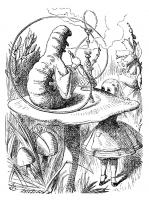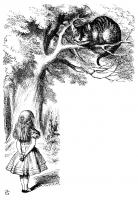Serendip is an independent site partnering with faculty at multiple colleges and universities around the world. Happy exploring!
Defining Dreams

The Dream of Definitions
In a dream world, the definitions of reality seem to be no longer viable. They become twisted and multiplied; each definition can be molded to a new form. The connections between objects and their definitions are liquid, and seemingly inapplicable to the waking reality. And yet, as Lewis Carroll proposes in Alice in Wonderland and Through the Looking-Glass, the dream world is not so different from reality –they are both absurd. If this is the case, could not the nature of definitions be fluid in reality as well as in dreams?
The nature of parody is that it holds a warped mirror up to its parent form, mocking and revealing the nature of its parent. As Lewis Carroll parodies our experiences of reality through the dream worlds of Alice, he exposes the similarities between the dream of Alice’s imagination and the real world. With each pun and play on definition, Carroll is not just revealing the fluidity of definitions in dreams, but also in the reality he parodies. Without this parody, it is harder to see the fluidity of definitions we assume firm and truthful in everyday life.

The difference between a kitten and queen is vast, and yet to the Alice of Carroll’s novels, they are one and the same: a baby human and a pig, the creature that makes mock turtle soup, poems with words that change in memory, card decks and chess pieces that come alive, speaking flowers, “Life, what is it but a dream?” –these are all the result of fluid definitions (Carroll 239).
When Alice finds herself down the rabbit hole, she approaches the new world of her dreams just as she approaches reality. Along with her other habits comes that of recitation, a skill she displays with vengeance, even as the words she recites find themselves changing. In order to prove that she is indeed herself, Alice attempts to recite “How doth the little busy bee,” but she finds herself substituting hungry crocodiles for the original hard working bees. When this happens, she decides, “I must be Mabel after all… if I’m Mabel, I’ll stay down here!” (Carroll 29). Her definition of self is challenged by the strange events occurring around her, causing Alice to assume she is more likely a playmate than herself. Carroll plays here, not only with Alice’s naiveté, but also with a parody of identity as physical and impermanent. When Alice says, “I’m sure I’m not Ada… for her hair goes in such long ringlets, and mine doesn’t go in ringlets at all,” the reader laughs that she could question or affirm her own identity solely on the basis of physical characteristics (Carroll 29). Carroll is not only playing with this, but also revealing how much human beings do define themselves by the bodies they are a part of.
Alice’s fixation on the physical is also seen in her encounter with the Mouse in Wonderland: “Mine is a long and a sad tale,” said the Mouse, turning to Alice, and sighing. “It is a long tail, certainly,” said Alice, looking down in wonder at the Mouse’s tail; “but why do you call it sad?” (Carroll 37). The double meaning of the word tale (as well as other puns throughout Carroll’s two novels) provides more than just a funny joke.

In questioning the nature of this definition, and the Mouse’s miscommunication, Carroll probes the nature of definitions. If words can be so easily misconstrued in this dream world, and if the readers recognize this confusion easily, isn’t it a parody of the confusion of definitions that occur in reality as well? The definitions man believes to be steady, and uses as solid constructions every day, are really as wavering as Alice’s dream world.
Alice is not the only character in Carroll’s stories who misquotes poetry. The Mad Hatter (manifested later in Through the Looking-Glass as Hatta) recites “Twinkle, twinkle, little star” as: “Twinkle, twinkle little bat!/ How I wonder what you’re at!/ Up above the world you fly,/ Like a tea-tray in the sky.” (Carroll 71-72). Not only this, but the Mad Hatter has personified Time to an absurd degree –perhaps Carroll is pointing out how absurd our own slight personification of time is, or how many ‘forms’ Time takes.
Not only Time, but Flowers as well: when Alice travels through the looking-glass to a new world in her dreams, she finds a lovely garden filled with talking flowers. But these flowers, when they talk to Alice, define her through the lens of a flower. They comment on her “colour” and one flower laments that “if only her petals curled up a little more, she’d be all right” (Carroll 141). They compare and define her based on their own prejudice, but isn’t this something we (as humans) do as well?
This prejudice, which comes with definitions, is also present in Carroll’s story of Alice and the Fawn. While both are lost in the forest where nothing has a name, Alice and the Fawn “walked together through the wood, Alice with her arms clasped lovingly round the soft neck of the Fawn, till they came out into another open field, and here the Fawn gave a sudden bound into the air, and shook itself free from Alice’s arm. “I’m a Fawn!” it cried out in a voice of delight. “And dear me! you’re a human child!” A sudden look of alarm came into its beautiful brown eyes, and in another moment it had darted away at full speed” (Carroll 157). Without names they were comfortable with each other, but with names the Fawn became scared, bounding away. Alice would no more harm the Fawn as a ‘human child’ as she would without that label, but the definition of ‘human child’ as something possibly cruel to the Fawn changes the dynamic of the two companions. The reader could laugh at this as a parody gone too far, but doesn’t it really question the absurd level on which this operates in reality?

Carroll wants us to realize, or at least question whether, this dream is closer to reality than at first glance. At the end of Through the Looking-Glass he writes this poem:
In a Wonderland they lie,
Dreaming as the days go by,
Dreaming as the summers die:
Every drifting down the stream—
Lingering in the golden gleam—
Life, what is it but a dream?” (Carroll 239).
Is Alice’s dream really reality? His statement goes both ways; if life is a dream, then the dream could also be life.
The parody that Carroll constructs in these novels gives more than laughter. It hints that Alice’s dream world (or any dream world) is no more absurd than reality, just bent in a reflection of it. The baby who also becomes a pig—this double definition could hold in both the reality and the dream worlds, if we broaden the definitional meaning of ‘pig.’ Poems whose words change—were they no less absurd before? And yet Alice senses that something is different about them, and they are not the poems she thinks she should remember. Alice, like the other creatures of Wonderland and those she finds through the looking-glass, is bound by definitions, both too narrow and too wide. Our world is also caught in the sway of these definitions, but more subtly. No human being is always conscious of the multiplicity of definitions –but should we be? Are these definitions too restrictive or confusing? Or, once again, do we just need to recognize their multiplicity in order to flourish?
Bibliography:
Lewis Carroll. Alice’s Adventures in Wonderland & Through the Looking-Glass. Signet Classic (New York: 1960).



Comments
Looking Back
Your essay about dreams reminds me of many of our older discussions:
Dreams - aybala50
"All That We See or Seem is but a Dream Within a Dream." - me
Response to Shayna S - skindeep
3/18 Class Notes - by you (in which we remember talking about the identity of a hammer)
and even the categories discussion during our time with blogs
Your essay relates back to the beginning of the class in which we put ourselves into categories, but found difficulty in the process of what should go where and even just defining ourselves. You write a lot about how fluid definitions are, and I agree with you. How, then, are we to define ourselves and our surroundings when faced with this notion of constant flux?
On slippage
rmeyers--
you've chosen to focus here on the deepest levels of the parody that is Alice in Wonderland: not just our illusion that our selves are fixed and coherent (that our insides match our outsides), but that we can actually use our words to say what we mean (that our outsides can match our insides), that naming things is a reliably useful activity. You might be interested in sbg90's Wonderland and the Parody of Meaning, which covers much of the same territory.
I'm curious to know more about what you make of all the "slippages" you identify as being present, not only in the dream world, but the "real" one. Are the questions you ask, in closing, "real" or rhetorical? Do you think that "we just need to recognize the multiplicity [of definitions] in order to flourish?" (I'm remembering your saying, in your response to my response to your last paper, that "limiting ourselves is never a good idea"). Or are you troubled by and worried about the implications of the "liquidity" you describe in such detail?
You say that the "definitions man believes to be steady, and uses as solid constructions every day, are really wavering." Much of the contemporary theorizing about language use actually focuses on this "wavering" quality; scholars have been looking @ the constructedness of words, both @ the arbitrary nature of the correlation between "sign" and "signified" in the first place, and then -- more interestingly to me -- on the "slippage" that inevitably occurs between output and uptake (the mouse says "tale," Alice hears "tail"; Alice says "dry," meaning one sense of the word, while the dodo bird understands another).
There's also been years of conversation on Serendip about the way in which mathematicians and scientists aim for "no slippage," no "ambiguity," in their professional communications, while humanists not only revel in the play that ambiguity invites, but actually see the function of language as inviting and encouraging that sort of play, the sort of communication that can only happen when the receiver "doesn't quite get" what the sender sent.
See The Two Cultures for the initial articulation and the Language Group for a continued discussion of these ideas. I also published a paper a couple of years ago that celebrated the productivity of such misunderstandings: see Where Words Arise, and Wherefore for an extended exploration, both of the hypothesis that natural language doesn't aim for exact correlations, and for some of the good stuff that might happen precisely because we don't exactly "get" what one another is saying.


Speaking of which--one thing I don't quite "get" in your paper is the way you're using Tenniel's illustrations. You posted earlier this week some thoughtful questions about the "sketchy" quality of these images, asking how integral or useful they are for "setting the mood" of Carroll's story. So let me turn your questions back on your own work: how integral are the images here, for the development of your argument? (They seem to me to interrupt rather than advance the narrative you are constructing.) What was your intention, and what do you think was achieved, by using them to punctuate the analysis you are developing? (I use the caterpillar and the cheshire cat as my own concluding images, because their question-asking resembles my own. This puts you, of course, in the position of Alice....!)